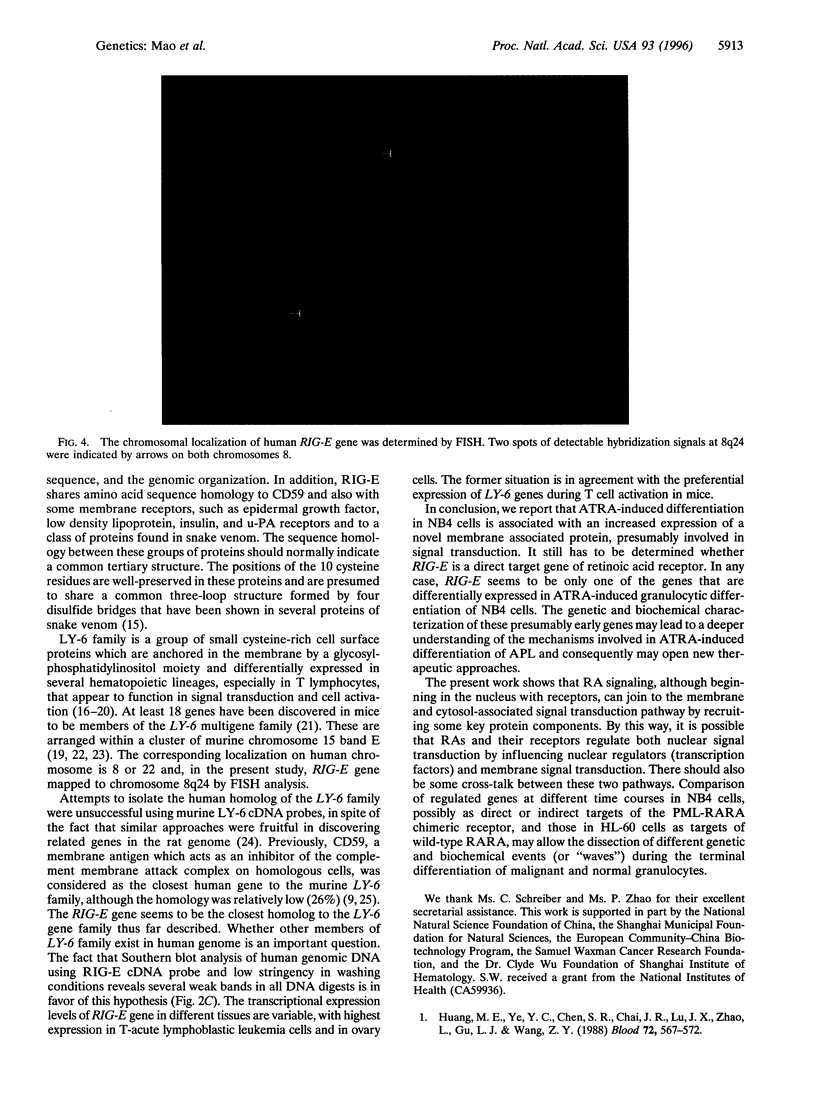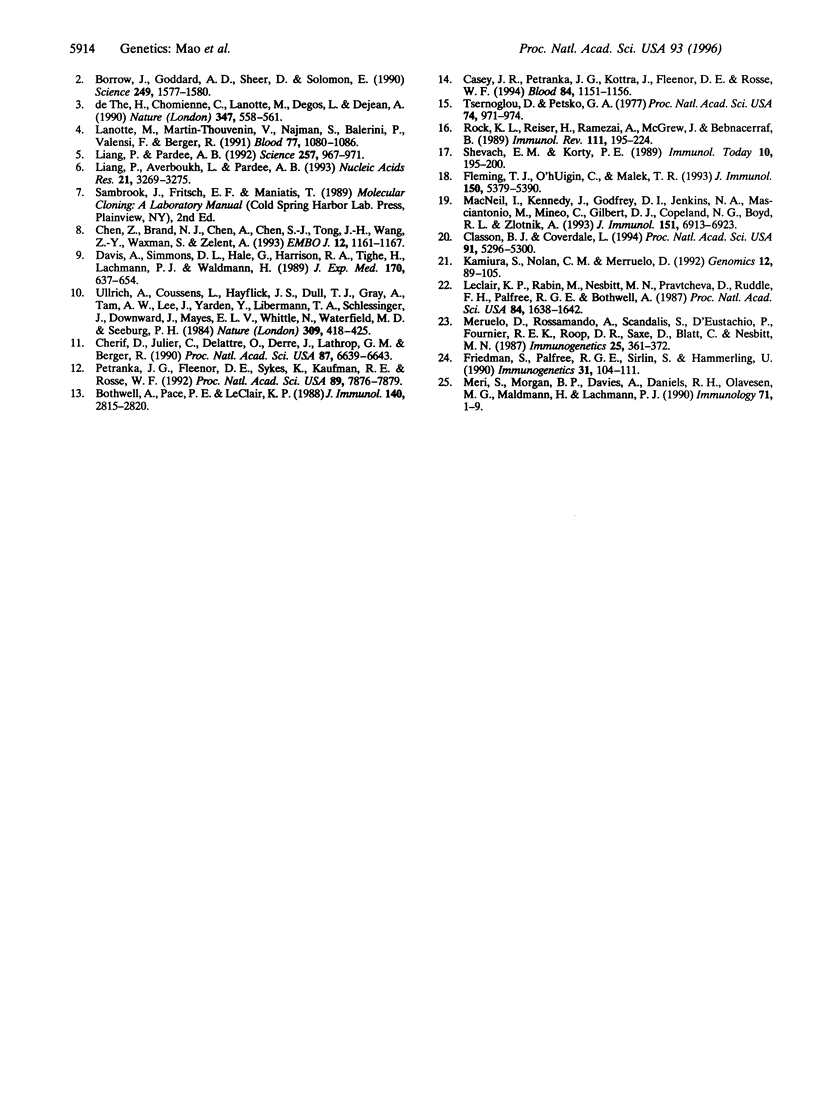Abstract
In vivo all-trans-retinoic acid (ATRA), a differentiation inducer, is capable of causing clinical remission in about 90% of patients with acute promyelocytic leukemia (APL). The molecular basis for the differentiation of APL cells after treatment with ATRA remains obscure and may involve genes other than the known retinoid nuclear transcription factors. We report here the ATRA-induced gene expression in a cell line (NB4) derived from a patient with APL. By differential display-PCR, we isolated and characterized a novel gene (RIG-E) whose expression is up-regulated by ATRA. The gene is 4.0 kb long, consisting of four exons and three introns, and is localized on human chromosome region 8q24. The deduced amino acid sequence predicts a cell surface protein containing 20 amino acids at the N-terminal end corresponding to a signal peptide and an extracellular sequence containing 111 amino acids. The RIG-E coded protein shares some homology with CD59 and with a number of growth factor receptors. It shares high sequence homology with the murine LY-6 multigene family, whose members are small cysteine-rich proteins differentially expressed in several hematopoietic cell lines and appear to function in signal transduction. It seems that so far RIG-E is the closest human homolog of the LY-6 family. Expression of RIG-E is not restricted to myeloid differentiation, because it is also present in thymocytes and in a number of other tissues at different levels.
Full text
PDF




Images in this article
Selected References
These references are in PubMed. This may not be the complete list of references from this article.
- Borrow J., Goddard A. D., Sheer D., Solomon E. Molecular analysis of acute promyelocytic leukemia breakpoint cluster region on chromosome 17. Science. 1990 Sep 28;249(4976):1577–1580. doi: 10.1126/science.2218500. [DOI] [PubMed] [Google Scholar]
- Bothwell A., Pace P. E., LeClair K. P. Isolation and expression of an IFN-responsive Ly-6C chromosomal gene. J Immunol. 1988 Apr 15;140(8):2815–2820. [PubMed] [Google Scholar]
- Casey J. R., Petranka J. G., Kottra J., Fleenor D. E., Rosse W. F. The structure of the urokinase-type plasminogen activator receptor gene. Blood. 1994 Aug 15;84(4):1151–1156. [PubMed] [Google Scholar]
- Chen Z., Brand N. J., Chen A., Chen S. J., Tong J. H., Wang Z. Y., Waxman S., Zelent A. Fusion between a novel Krüppel-like zinc finger gene and the retinoic acid receptor-alpha locus due to a variant t(11;17) translocation associated with acute promyelocytic leukaemia. EMBO J. 1993 Mar;12(3):1161–1167. doi: 10.1002/j.1460-2075.1993.tb05757.x. [DOI] [PMC free article] [PubMed] [Google Scholar]
- Cherif D., Julier C., Delattre O., Derré J., Lathrop G. M., Berger R. Simultaneous localization of cosmids and chromosome R-banding by fluorescence microscopy: application to regional mapping of human chromosome 11. Proc Natl Acad Sci U S A. 1990 Sep;87(17):6639–6643. doi: 10.1073/pnas.87.17.6639. [DOI] [PMC free article] [PubMed] [Google Scholar]
- Classon B. J., Coverdale L. Mouse stem cell antigen Sca-2 is a member of the Ly-6 family of cell surface proteins. Proc Natl Acad Sci U S A. 1994 Jun 7;91(12):5296–5300. doi: 10.1073/pnas.91.12.5296. [DOI] [PMC free article] [PubMed] [Google Scholar]
- Davies A., Simmons D. L., Hale G., Harrison R. A., Tighe H., Lachmann P. J., Waldmann H. CD59, an LY-6-like protein expressed in human lymphoid cells, regulates the action of the complement membrane attack complex on homologous cells. J Exp Med. 1989 Sep 1;170(3):637–654. doi: 10.1084/jem.170.3.637. [DOI] [PMC free article] [PubMed] [Google Scholar]
- Fleming T. J., O'hUigin C., Malek T. R. Characterization of two novel Ly-6 genes. Protein sequence and potential structural similarity to alpha-bungarotoxin and other neurotoxins. J Immunol. 1993 Jun 15;150(12):5379–5390. [PubMed] [Google Scholar]
- Friedman S., Palfree R. G., Sirlin S., Hämmerling U. Analysis of three distinct Ly6-A-related cDNA sequences isolated from rat kidney. Immunogenetics. 1990;31(2):104–111. doi: 10.1007/BF00661220. [DOI] [PubMed] [Google Scholar]
- Huang M. E., Ye Y. C., Chen S. R., Chai J. R., Lu J. X., Zhoa L., Gu L. J., Wang Z. Y. Use of all-trans retinoic acid in the treatment of acute promyelocytic leukemia. Blood. 1988 Aug;72(2):567–572. [PubMed] [Google Scholar]
- Kamiura S., Nolan C. M., Meruelo D. Long-range physical map of the Ly-6 complex: mapping the Ly-6 multigene family by field-inversion and two-dimensional gel electrophoresis. Genomics. 1992 Jan;12(1):89–105. doi: 10.1016/0888-7543(92)90411-k. [DOI] [PubMed] [Google Scholar]
- Lanotte M., Martin-Thouvenin V., Najman S., Balerini P., Valensi F., Berger R. NB4, a maturation inducible cell line with t(15;17) marker isolated from a human acute promyelocytic leukemia (M3). Blood. 1991 Mar 1;77(5):1080–1086. [PubMed] [Google Scholar]
- LeClair K. P., Rabin M., Nesbitt M. N., Pravtcheva D., Ruddle F. H., Palfree R. G., Bothwell A. Murine Ly-6 multigene family is located on chromosome 15. Proc Natl Acad Sci U S A. 1987 Mar;84(6):1638–1642. doi: 10.1073/pnas.84.6.1638. [DOI] [PMC free article] [PubMed] [Google Scholar]
- Liang P., Averboukh L., Pardee A. B. Distribution and cloning of eukaryotic mRNAs by means of differential display: refinements and optimization. Nucleic Acids Res. 1993 Jul 11;21(14):3269–3275. doi: 10.1093/nar/21.14.3269. [DOI] [PMC free article] [PubMed] [Google Scholar]
- Liang P., Pardee A. B. Differential display of eukaryotic messenger RNA by means of the polymerase chain reaction. Science. 1992 Aug 14;257(5072):967–971. doi: 10.1126/science.1354393. [DOI] [PubMed] [Google Scholar]
- MacNeil I., Kennedy J., Godfrey D. I., Jenkins N. A., Masciantonio M., Mineo C., Gilbert D. J., Copeland N. G., Boyd R. L., Zlotnik A. Isolation of a cDNA encoding thymic shared antigen-1. A new member of the Ly6 family with a possible role in T cell development. J Immunol. 1993 Dec 15;151(12):6913–6923. [PubMed] [Google Scholar]
- Meri S., Morgan B. P., Davies A., Daniels R. H., Olavesen M. G., Waldmann H., Lachmann P. J. Human protectin (CD59), an 18,000-20,000 MW complement lysis restricting factor, inhibits C5b-8 catalysed insertion of C9 into lipid bilayers. Immunology. 1990 Sep;71(1):1–9. [PMC free article] [PubMed] [Google Scholar]
- Meruelo D., Rossomando A., Scandalis S., D'Eustachio P., Fournier R. E., Roop D. R., Saxe D., Blatt C., Nesbitt M. N. Assignment of the Ly-6--Ril-1--Sis--H-30--Pol-5/Xmmv-72--Ins-3--Krt-1--Int-1 --Gdc-1 region to mouse chromosome 15. Immunogenetics. 1987;25(6):361–372. doi: 10.1007/BF00396102. [DOI] [PubMed] [Google Scholar]
- Petranka J. G., Fleenor D. E., Sykes K., Kaufman R. E., Rosse W. F. Structure of the CD59-encoding gene: further evidence of a relationship to murine lymphocyte antigen Ly-6 protein. Proc Natl Acad Sci U S A. 1992 Sep 1;89(17):7876–7879. doi: 10.1073/pnas.89.17.7876. [DOI] [PMC free article] [PubMed] [Google Scholar]
- Rock K. L., Reiser H., Bamezai A., McGrew J., Benacerraf B. The LY-6 locus: a multigene family encoding phosphatidylinositol-anchored membrane proteins concerned with T-cell activation. Immunol Rev. 1989 Oct;111:195–224. doi: 10.1111/j.1600-065x.1989.tb00547.x. [DOI] [PubMed] [Google Scholar]
- Shevach E. M., Korty P. E. Ly-6: a multigene family in search of a function. Immunol Today. 1989 Jun;10(6):195–200. doi: 10.1016/0167-5699(89)90324-1. [DOI] [PubMed] [Google Scholar]
- Tsernoglou D., Petsko G. A. Three-dimensional structure of neurotoxin a from venom of the Philippines sea snake. Proc Natl Acad Sci U S A. 1977 Mar;74(3):971–974. doi: 10.1073/pnas.74.3.971. [DOI] [PMC free article] [PubMed] [Google Scholar]
- Ullrich A., Coussens L., Hayflick J. S., Dull T. J., Gray A., Tam A. W., Lee J., Yarden Y., Libermann T. A., Schlessinger J. Human epidermal growth factor receptor cDNA sequence and aberrant expression of the amplified gene in A431 epidermoid carcinoma cells. 1984 May 31-Jun 6Nature. 309(5967):418–425. doi: 10.1038/309418a0. [DOI] [PubMed] [Google Scholar]
- de Thé H., Chomienne C., Lanotte M., Degos L., Dejean A. The t(15;17) translocation of acute promyelocytic leukaemia fuses the retinoic acid receptor alpha gene to a novel transcribed locus. Nature. 1990 Oct 11;347(6293):558–561. doi: 10.1038/347558a0. [DOI] [PubMed] [Google Scholar]





